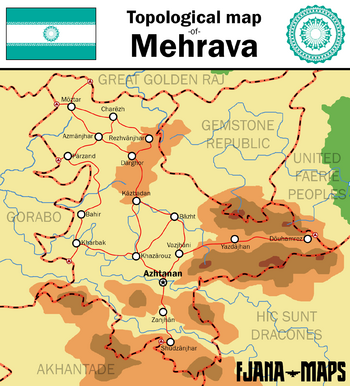Mehrava
Militarized State of Mehrava Mizardâd Shâqdarâv Mehravâ | |
|---|---|
| Motto: 'Guriyanfâr Mehravâ!' | |
| Anthem: "Humarz Muztananûv" Hums of the Mountains | |
 Geographical map of Mehrava, including major cities and roads. | |
| Capital | Azhtanan |
| Largest city | Môztar |
| Official languages | Mehrani |
| Recognised regional languages | Arabic |
| Ethnic groups | 95.8% Mehrani 4.2% Arab |
| Demonym(s) | Mehravan |
| Government | Military junta |
• Supreme Leader | Arzhan Admejhad |
| Establishment | |
• Supreme Council for National Reconstruction of Mehrava | 1985 |
• Militarization | 1990 |
| Area | |
• Total | 1,313,351 km2 (507,088 sq mi) |
| Population | |
• 2020 estimate | 83,987,229 |
• 2019 census | 83,183,741 |
| GDP (nominal) | 2019 estimate |
• Total | 917.000 billion $ACU |
• Per capita | 11,012 $ACU |
| HDI (2019) | 0.813 very high |
| Currency | Mehraz (MMR) |
| Time zone | UTC-2 (UTC) |
| Date format | DD/MM/YYYY |
| Driving side | left |
| Calling code | +84 |
| Internet TLD | .mrv |
Mehrava, officially known as The Militarized State of Mehrava, is a medium-large sized country on the western area of Thrismari, bordering Gemstone Republic & United Fairie Peoples to the east, and Gorabo to the west, Mehrava is a landlocked country with an area of 1,313,351 square kilometres (507,087 sq mi), with a decently intrustrialized economy especially its oil & gas industry which generates 65% of the country's GDP. It also has vast mineral resources.
The terrain of Mehrava includes steppes, plains, hills, deltas, snow-capped mountains, and deserts. Mehrava has an estimated 83.9 million people as of 2020. Since 1987, the capital is Azhtanan, formerly known as Qârza. It was moved from Môztar, the country's largest city.
The territory of Mehrava has historically been inhabited by nomadic groups and empires. In antiquity, the nomadic tribes inhabited the northern steppes and the mountainous tribes settled in the mountain ranges in the southeast all of which would be conquered by the Goraboese Caliphate from the west later on.
In the 7th century, the territory was subjugated by the Goraboese Caliphate under the Caliph. By the 12th century, the Mehranis emerged as a distinct group, divided into three Khanates (ancestor branches occupying specific territories). In the 14th century, all the Mehrani tribes was united into a single horde called the Qârzuk Khanate which was led by Qârzuk the Great himself and created the Qârzukid dynasty which would rule Mehrava until the 19th century when Arzhanids captured the throne. a
According to the 2019 census, Mehrava's 10 ethnicities include Mehranis (95.8% of the population), Arabs, Assyrians, Jews. Per 2019 census, Islam is the religion of about 90% of the population, with Christianity practised by 5%. Mehrava officially allows freedom of religion, but religious leaders who oppose the government are suppressed.
Etymology
The name "Mehrava" comes from the ancient Mehrani word mehr, "to wander", reflecting the Mehranis' nomadic culture. The suffix -va means "land" or "place of", so Mehrava can be literally translated as "land of the wanderers".
Though the term traditionally referred only to ethnic Mehranis, including those living in Gorabo, Gassasinia, Lakkatha and other neighbouring countries, the term Mehrani is increasingly being used to refer to any inhabitant of Mehrava, including non-Mehranis.
Military
As of 2020, Mehrava has an army of 500,000 active-duty soldiers with 2,000,000 reservists on stand-by who can be deployed as needed to fill demands, along with 200,000 Military Police militia reservists who are deployed in times of war to defend the homeland while the highly mobile Regular Army carries out offensive actions against any invaders. Equipped with 2,720 tanks and 3,788 infantry fighting vehicles, along with 211 combat aircraft, the Mehravan Armed Forces is well-equipped, well-trained and well-organised. Military spending in Mehrava is at about 4.1% of the national GDP.

